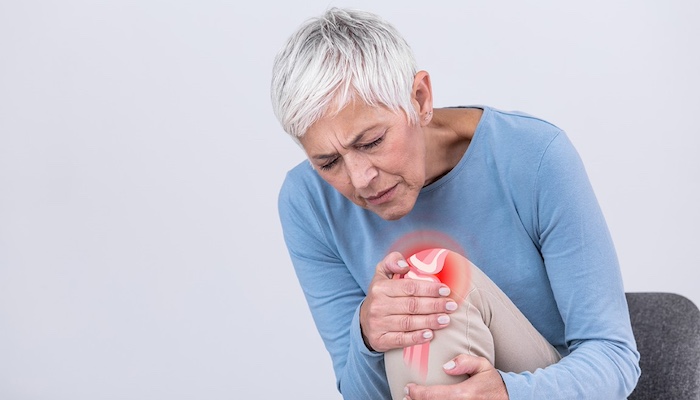
Osteoarthritis can lead to joint pain and stiffness. Medications, lifestyle changes, and surgery may help reduce pain and inflammation.
Osteoarthritis is a degenerative joint disease resulting in inflammation, stiffness, and pain. It’s the most common type of arthritis, affecting about 32.5 million people in the United States.
As the disease progresses, osteoarthritis can limit mobility and decrease quality of life. However, treatment can slow its advancement.
Continue reading to discover more about the symptoms, types, causes, and treatments for osteoarthritis.
Osteoarthritis Symptoms
Symptoms of osteoarthritis vary based on the severity of the condition and the area affected. Common signs include:
- Joint pain
- Stiffness
- Loss of flexibility
- Decreased range of motion
- Tenderness when pressing on the affected areas
- Joint inflammation
- Crepitus (grating or popping sounds during joint movement)
- Bone spurs (usually painless lumps)
As osteoarthritis worsens, pain may intensify, and swelling in the joint and surrounding areas may develop.
Causes of Osteoarthritis
Osteoarthritis occurs due to gradual damage to the joints and cartilage. Cartilage is a rubbery material that cushions the ends of bones, allowing smooth movement. Over time, the cartilage wears down, making the bones rub against each other, causing pain and other symptoms.
Though the exact cause remains unknown, certain risk factors have been identified, including:
- Genetics
- Previous injuries (e.g., torn cartilage, dislocated joints)
- Age (especially over 50)
- Female gender
- Overweight or obesity
- Menopause
- Occupations requiring repetitive joint strain
- Other medical conditions affecting joints
Types of Osteoarthritis
Osteoarthritis can affect various joints, most commonly the knees and hips. Other affected areas include:
- Hands
- Fingers
- Shoulders
- Spine
- Cervical area (neck)
As osteoarthritis progresses, it can spread to other body parts, increasing the likelihood of developing the condition in additional joints.
Stages of Osteoarthritis
Osteoarthritis progresses through four stages:
- Stage 1 (Mild): Early symptoms, but the cartilage remains intact.
- Stage 2 (Moderate): More pronounced symptoms with visible cartilage damage.
- Stage 3 (Advanced): Constant symptoms and significant cartilage loss.
- Stage 4 (Severe): Intense pain, decreased motion, joint instability, and possibly muscle weakness or deformity.
In severe cases, surgery may be necessary to alleviate symptoms and restore mobility.
Osteoarthritis Diagnosis
Osteoarthritis typically develops gradually, making early diagnosis challenging. A healthcare provider will examine you, review your symptoms, and possibly order imaging tests like X-rays or MRIs. Blood tests or joint fluid analysis may also be used to rule out other conditions, such as rheumatoid arthritis or gout.
Treatment for Osteoarthritis
Although there is no cure for osteoarthritis, treatment aims to manage symptoms, improve joint function, and enhance quality of life. A tailored treatment plan may include:
- Lifestyle changes (exercise, sleep, weight management)
- Anti-inflammatory diet
- Natural remedies (yoga, supplements, hot/cold therapy)
- Over-the-counter medications (NSAIDs)
- Prescription drugs (corticosteroids)
- Physical therapy
- Assistive devices (e.g., knee braces)
- Surgery (e.g., joint replacement)
Complications of Osteoarthritis
Untreated osteoarthritis can lead to physical, emotional, and mental health issues, such as:
- Increased joint stiffness and limited mobility
- Higher risk of falls and injuries
- Sleep disturbances
- Weight gain
- Anxiety or depression
- Bone necrosis
- Ligament or tendon damage
- Hairline fractures
- Hemarthrosis (joint bleeding)
Preventing Osteoarthritis
While certain risk factors like genetics and age cannot be changed, other risks can be minimized through:
- Maintaining a healthy weight
- Regular low-impact exercise (at least 150 minutes weekly)
- Managing blood sugar (for diabetes)
- Controlling blood pressure (for hypertension)
- Eating an anti-inflammatory diet
- Using proper lifting techniques
- Wearing appropriate footwear
Osteoarthritis vs. Rheumatoid Arthritis
Although osteoarthritis and rheumatoid arthritis (RA) share similar symptoms, they are distinct conditions. Osteoarthritis is degenerative, while RA is an autoimmune disorder where the immune system attacks the joint lining. Both conditions can cause joint damage over time, but RA also leads to swelling from fluid buildup in the joints.
Final Thoughts
Osteoarthritis is a chronic condition causing pain, stiffness, and inflammation. While there is no cure, a well-structured treatment plan can help manage symptoms, improve mobility, and enhance quality of life. Consult a healthcare provider for a diagnosis and personalized treatment plan if you suspect you may have osteoarthritis.
Precision Pain Care and Rehabilitation has two convenient locations in Richmond Hill – Queens, and New Hyde Park – Long Island. Call the Queens office at (718) 215-1888 or (516) 419-4480 for the Long Island office to arrange an appointment with our Interventional Pain Management Specialists, Dr. Jeffrey Chacko or Dr. Sonny Ahluwalia.















